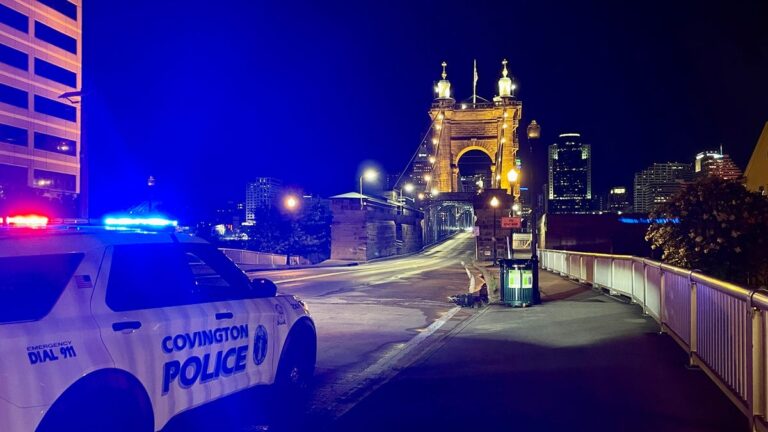I am disappointed in the leadership who involved normal vigil attendees in a risky protest they didn’t even know was going on.
Covington police subdue multiple people during Roebling Bridge protest
Videos show Covington officers subduing people during the July 17 protest. Police said they were “met with open hostility” when dispersing the group.
Gracie Shanklin, Provided
By now, you may have seen the major altercation that occurred between demonstrators and police on the Roebling Bridge on July 17. If not, here’s the short version of what happened.
There was a vigil to support Imam Ayman Soliman, whom ICE detained last week. Afterward, an estimated 100 participants marched across the bridge, blocking the middle of the road and shutting it down. The vigil was peaceful, but the march was not.
While on the bridge, some demonstrators refused to move out of the way of traffic when told to by Cincinnati and Covington police officers. Consequently, the police used violent means (pepper balls, Tasers, fists) to force compliance and reopen the road.
Reasonable observers may differ in their assessment of the situation − the extent to which it was wise to disrupt traffic, who did or did not obey police orders and the use of violent crowd-control methods by law enforcement. I’m not so chutzpadik (bold) as to imagine my perspective on such things is the end-all be-all; however, I do think certain perspectives are worth hearing in the chaos’ aftermath.
Violence took away from the message of the protest
First, I am greatly saddened to see that this violence has drawn attention away from Imam Soliman and his plight. A plethora of news outlets were already at the vigil and prepared to cover it before the “bridge situation” took place. The framing of those stories now has changed, focusing less on the vigil and ICE’s concerning behavior and more on the violence of the evening itself.
This does nothing to help Imam Soliman. Based on the interactions I’ve had with community members, this has lost him support among many people who were on the fence before. In a time when government forces are breaking communities by pursuing vulnerable non-citizens, we should be doing everything possible to keep the story laser-focused on that, and not on other issues.
Second, Covington police said the arrests came after people “obstructed traffic and created safety concerns for both demonstrators and the public” when they crossed the Ohio River bridge. “We respect everyone’s right to protest, but when demonstrations jeopardize public safety and violate the law, our officers must take appropriate action,” Police Chief Brian Valenti said in a news release.
In my opinion, there was no need for the escalation brought on by law enforcement, especially on the Covington side of the Roebling Bridge.
I can appreciate the desire of police officers to break up an unsanctioned demonstration that is disrupting traffic; I do not have a negative reaction to everything law enforcement officers do. However, I find it hard to see the videos and hear the testimonials that have emerged since July 17 without thinking that at least some members of the Covington Police Department were too willing to escalate the situation.
In such moments of chaos, I want our law enforcement to judiciously use the tools at their disposal to restore order. Disruptive as the protest may have been, there was no extreme urgency to break it up such that the police couldn’t have waited longer to clear the group out, giving more warnings. Frankly, it feels that the police may have played directly into the hands of some of the more extreme folks on the bridge. Some likely wanted there to be a showdown, and they managed to get one.
Vigil attendees were unaware of protest. Leaders must do better.
More than all, as time passes since that night (and, admittedly, it’s been fewer than 24 hours), I grow increasingly disappointed in the leadership who involved normal vigil attendees in a risky protest they didn’t even know was going on. From conversations I’ve had with people who went on the bridge, many of them had no idea of what was about to happen or even that the demonstration they were joining wasn’t permitted.
The attempt to shut down the Roebling Bridge, from what I have heard, was not organic − it was planned. For days, I’d heard people discuss the possibility that this might occur and had speculated about the extent to which it might be sanctioned and safe. I didn’t participate precisely because I couldn’t get such assurances − while the vigil moved to the bridge, I stayed back to observe with friends.
It is fine for activists and organizers, who are aware of all the risks of being part of civil disobedience, to put themselves in potential danger. It is entirely another thing for members of a crowd to be brought into someone else’s attempt at disruption without recognizing it as such. When choosing how to involve others in our community engagement, it is our responsibility as leaders to “do the homework” to ensure the settings into which we lead our people are sufficiently safe. And, when we can’t feel certain enough that they are safe, it is our job to communicate that to potential collaborators.
And, seeing how everything went in the evening, it is clear that people who didn’t know what they were doing were taking risks they didn’t understand. Thank God, things didn’t go even worse − this whole situation could have been deadly.
As this event moves out of the news cycle, I hope focus will return to Imam Soliman and the help he needs. We must direct our zeal for justice in the right direction, not letting it get in the way of accomplishing our goals.
Ari Jun is the senior rabbi of Cincinnati’s Temple Sholom.

